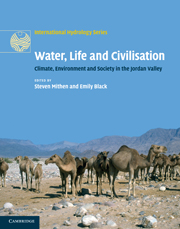Book contents
- Frontmatter
- Contents
- List of figures
- List of tables
- List of contributors
- Acknowledgements
- 1 Introduction: an interdisciplinary approach to Water, Life and Civilisation
- Part I Past, present and future climate
- Part II The palaeoenvironmental record
- 6 A review of palaeoclimates and palaeoenvironments in the Levant and Eastern Mediterranean from 25,000 to 5,000 years BP: setting the environmental background for the evolution of human civilisation
- 7 Palaeoenvironments of the southern Levant 5,000 BP to present: linking the geological and archaeological records
- 8 Using proxy data, historical climate data and climate models to investigate aridification during the Holocene
- 9 Palaeoenvironmental and limnological reconstruction of Lake Lisan and the Dead Sea
- Part III Hydrological studies of the Jordan Valley
- Part IV Human settlement, climate change, hydrology and water management
- Part V Palaeoeconomies and developing archaeological methodologies
- Part VI Society, economy and water today
- Part VII Conclusions
- Index
- Plate section
- References
7 - Palaeoenvironments of the southern Levant 5,000 BP to present: linking the geological and archaeological records
from Part II - The palaeoenvironmental record
Published online by Cambridge University Press: 26 April 2011
- Frontmatter
- Contents
- List of figures
- List of tables
- List of contributors
- Acknowledgements
- 1 Introduction: an interdisciplinary approach to Water, Life and Civilisation
- Part I Past, present and future climate
- Part II The palaeoenvironmental record
- 6 A review of palaeoclimates and palaeoenvironments in the Levant and Eastern Mediterranean from 25,000 to 5,000 years BP: setting the environmental background for the evolution of human civilisation
- 7 Palaeoenvironments of the southern Levant 5,000 BP to present: linking the geological and archaeological records
- 8 Using proxy data, historical climate data and climate models to investigate aridification during the Holocene
- 9 Palaeoenvironmental and limnological reconstruction of Lake Lisan and the Dead Sea
- Part III Hydrological studies of the Jordan Valley
- Part IV Human settlement, climate change, hydrology and water management
- Part V Palaeoeconomies and developing archaeological methodologies
- Part VI Society, economy and water today
- Part VII Conclusions
- Index
- Plate section
- References
Summary
ABSTRACT
In this chapter we review climatic and environmental changes during the middle to late Holocene in the southern Levant, and their potential impact on human communities. The Holocene is characterised in the eastern Mediterranean region by a trend towards aridity. Several climatic fluctuations are superimposed on this general trend, but contradictory palaeoenvironmental evidence often renders these variations difficult to characterise and date accurately. Nevertheless, the cultural changes at the end of the Early Bronze Age and the Byzantine period appear to be clearly related to a shift towards aridity. Relatively wetter conditions seem to prevail during the Chalcolithic to Early Bronze Age, and during the Hellenistic to Byzantine period. The first of these humid periods may be related to a decline in settlements in the Israeli coastal plain during the Early Bronze Age, caused by increased flooding and the spread of diseases in a marshy environment. The second is associated with thriving agriculture. Arid conditions are prevalent during the Early Islamic period to modern times. More contradictory information characterises the Middle Bronze to Iron Age, but arid conditions are likely to have been dominant at the end of the Middle Bronze Age as well as during the first half of the Iron Age. Phases of climate instability occurred at c. 5,200–5,000 BP and c. 1,000 BP, the latter being coeval with the demise of the Decapolis society.
- Type
- Chapter
- Information
- Water, Life and CivilisationClimate, Environment and Society in the Jordan Valley, pp. 94 - 104Publisher: Cambridge University PressPrint publication year: 2011
References
- 10
- Cited by



